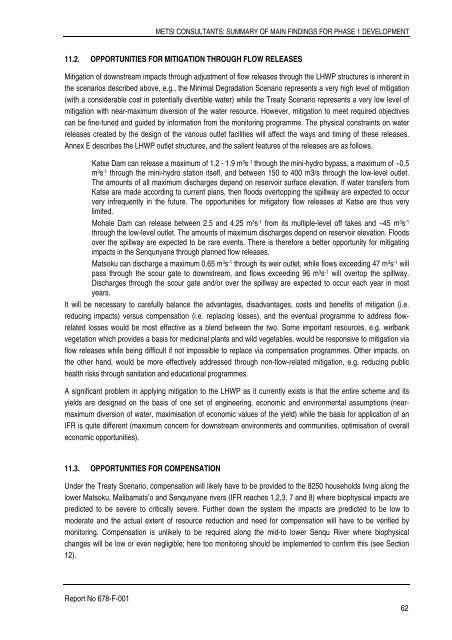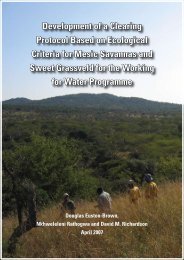Metsi Consultants - DWA Home Page
Metsi Consultants - DWA Home Page
Metsi Consultants - DWA Home Page
Create successful ePaper yourself
Turn your PDF publications into a flip-book with our unique Google optimized e-Paper software.
Report No 678-F-001<br />
METSI CONSULTANTS: SUMMARY OF MAIN FINDINGS FOR PHASE 1 DEVELOPMENT<br />
11.2. OPPORTUNITIES FOR MITIGATION THROUGH FLOW RELEASES<br />
Mitigation of downstream impacts through adjustment of flow releases through the LHWP structures is inherent in<br />
the scenarios described above, e.g., the Minimal Degradation Scenario represents a very high level of mitigation<br />
(with a considerable cost in potentially divertible water) while the Treaty Scenario represents a very low level of<br />
mitigation with near-maximum diversion of the water resource. However, mitigation to meet required objectives<br />
can be fine-tuned and guided by information from the monitoring programme. The physical constraints on water<br />
releases created by the design of the various outlet facilities will affect the ways and timing of these releases.<br />
Annex E describes the LHWP outlet structures, and the salient features of the releases are as follows.<br />
Katse Dam can release a maximum of 1.2 - 1.9 m 3 s -1 through the mini-hydro bypass, a maximum of ~0.5<br />
m 3 s -1 through the mini-hydro station itself, and between 150 to 400 m3/s through the low-level outlet.<br />
The amounts of all maximum discharges depend on reservoir surface elevation. If water transfers from<br />
Katse are made according to current plans, then floods overtopping the spillway are expected to occur<br />
very infrequently in the future. The opportunities for mitigatory flow releases at Katse are thus very<br />
limited.<br />
Mohale Dam can release between 2.5 and 4.25 m 3 s -1 from its multiple-level off takes and ~45 m 3 s -1<br />
through the low-level outlet. The amounts of maximum discharges depend on reservoir elevation. Floods<br />
over the spillway are expected to be rare events. There is therefore a better opportunity for mitigating<br />
impacts in the Senqunyane through planned flow releases.<br />
Matsoku can discharge a maximum 0.65 m 3 s -1 through its weir outlet, while flows exceeding 47 m 3 s -1 will<br />
pass through the scour gate to downstream, and flows exceeding 96 m 3 s -1 will overtop the spillway.<br />
Discharges through the scour gate and/or over the spillway are expected to occur each year in most<br />
years.<br />
It will be necessary to carefully balance the advantages, disadvantages, costs and benefits of mitigation (i.e.<br />
reducing impacts) versus compensation (i.e. replacing losses), and the eventual programme to address flowrelated<br />
losses would be most effective as a blend between the two. Some important resources, e.g. wetbank<br />
vegetation which provides a basis for medicinal plants and wild vegetables, would be responsive to mitigation via<br />
flow releases while being difficult if not impossible to replace via compensation programmes. Other impacts, on<br />
the other hand, would be more effectively addressed through non-flow-related mitigation, e.g. reducing public<br />
health risks through sanitation and educational programmes.<br />
A significant problem in applying mitigation to the LHWP as it currently exists is that the entire scheme and its<br />
yields are designed on the basis of one set of engineering, economic and environmental assumptions (nearmaximum<br />
diversion of water, maximisation of economic values of the yield) while the basis for application of an<br />
IFR is quite different (maximum concern for downstream environments and communities, optimisation of overall<br />
economic opportunities).<br />
11.3. OPPORTUNITIES FOR COMPENSATION<br />
Under the Treaty Scenario, compensation will likely have to be provided to the 8250 households living along the<br />
lower Matsoku, Malibamats’o and Senqunyane rivers (IFR reaches 1,2,3, 7 and 8) where biophysical impacts are<br />
predicted to be severe to critically severe. Further down the system the impacts are predicted to be low to<br />
moderate and the actual extent of resource reduction and need for compensation will have to be verified by<br />
monitoring. Compensation is unlikely to be required along the mid-to lower Senqu River where biophysical<br />
changes will be low or even negligible; here too monitoring should be implemented to confirm this (see Section<br />
12).<br />
62

















